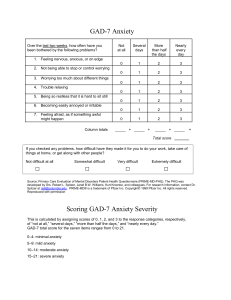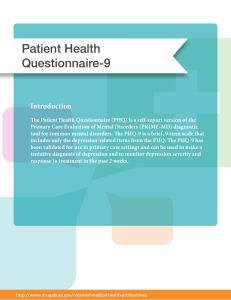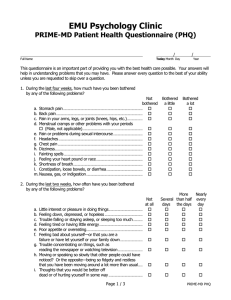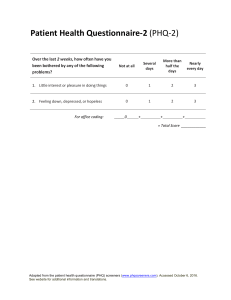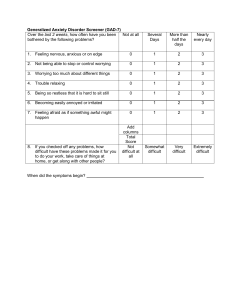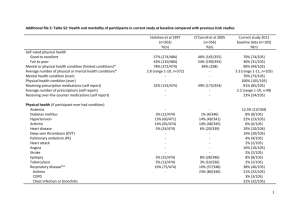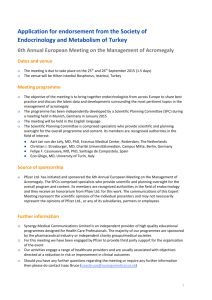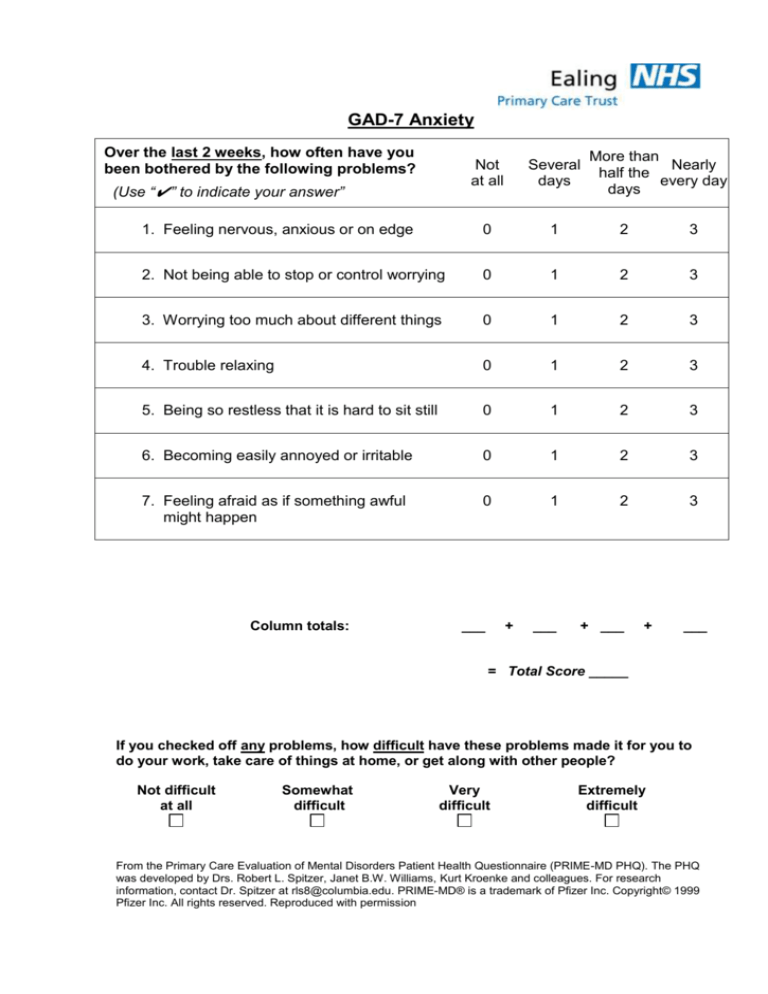
GAD-7 Anxiety
Over the last 2 weeks, how often have you
been bothered by the following problems?
More than
Nearly
half the
every day
days
Not
at all
Several
days
1. Feeling nervous, anxious or on edge
0
1
2
3
2. Not being able to stop or control worrying
0
1
2
3
3. Worrying too much about different things
0
1
2
3
4. Trouble relaxing
0
1
2
3
5. Being so restless that it is hard to sit still
0
1
2
3
6. Becoming easily annoyed or irritable
0
1
2
3
7. Feeling afraid as if something awful
might happen
0
1
2
3
(Use “✔” to indicate your answer”
Column totals:
___
+
___
+ ___
+
___
= Total Score _____
If you checked off any problems, how difficult have these problems made it for you to
do your work, take care of things at home, or get along with other people?
Not difficult
at all
Somewhat
difficult
Very
difficult
Extremely
difficult
From the Primary Care Evaluation of Mental Disorders Patient Health Questionnaire (PRIME-MD PHQ). The PHQ
was developed by Drs. Robert L. Spitzer, Janet B.W. Williams, Kurt Kroenke and colleagues. For research
information, contact Dr. Spitzer at rls8@columbia.edu. PRIME-MD® is a trademark of Pfizer Inc. Copyright© 1999
Pfizer Inc. All rights reserved. Reproduced with permission
PHQ-9 Depression
Over the last 2 weeks, how often have you
been bothered by any of the following problems?
(Use “✔” to indicate your answer”
Not
all
More
than
Nearly
at Several half the every
days
days
day
1. Little interest or pleasure in doing things.......………
0
1
2
3
2. Feeling down, depressed, or hopeless.………..……
0
1
2
3
2
3
3. Trouble falling or staying asleep, or sleeping too
much..................................................………..……..
0
1
4. Feeling tired or having little energy......……...………
0
1
2
3
5. Poor appetite or overeating.......................……….…
0
1
2
3
6. Feeling bad about yourself — or that you are a failure
or have let yourself or your family down…………………..
0
1
2
3
7. Trouble concentrating on things, such as reading the
newspaper or watching television.………………………..
0
1
2
3
8. Moving or speaking so slowly that other people could
have noticed? Or the opposite — being so fidgety or
restless that you have been moving .around a lot more than
usual..............………………………………………………..
0
1
2
3
9. Thoughts that you would be better off dead or of hurting
yourself in some way......……………………………………
0
1
2
3
Column totals
___
+ ___ + ____ + ___
= Total Score _____
From the Primary Care Evaluation of Mental Disorders Patient Health Questionnaire (PRIME-MD PHQ). The PHQ
was developed by Drs. Robert L. Spitzer, Janet B.W. Williams, Kurt Kroenke and colleagues. For research
information, contact Dr. Spitzer at rls8@columbia.edu. PRIME-MD® is a trademark of Pfizer Inc. Copyright© 1999
Pfizer Inc. All rights reserved. Reproduced with permission
Scoring notes.
PHQ-9 Depression Severity
Scores represent: 0-5 = mild
16-20 = severe depression
6-10 = moderate
11-15 = moderately severe
GAD-7 Anxiety Severity.
This is calculated by assigning scores of 0, 1, 2, and 3, to the response categories of “not at all,”
“several days,” “more than half the days,” and “nearly every day,” respectively. GAD-7 total score
for the seven items ranges from 0 to 21.
Scores represent: 0-5 mild 6-10 moderate 11-15 moderately severe anxiety
15-21 severe anxiety.
Core-10
Key points in the scoring of the CORE-10 are as follows:
1. Each item within the CORE-10 is scored on a 5-point scale ranging from 0 (‘not at all’)
to 4 (‘most or all the time’).
2. The clinical score is calculated by adding the response values of all 10 items.
3. Where there are missing data the clinical score is derived by calculating the total mean
score (dividing the total score by the number of completed items) and multiplying by
10.
4. We do not recommend re-scaling the clinical score if more than one item is missing.
5. The minimum score that can be achieved is 0 and the maximum is 40.
6. The measure is problem scored, that is, the higher the score the more problems the
individual is reporting and/or the more distressed they are.
A score of 10 or below denotes a score within the non-clinical range and of 11 or
above within the clinical range. Within the non-clinical range we have identified two
bands called ‘healthy’ and ‘low’ level distress. People may score on a number of items at
any particular time but still remain ‘healthy’. Similarly, people may score in the ‘low’ range
which might be a result of raised pressures or particular circumstances but which is still
within a non-clinical range. Within the clinical range we have identified the score of
11 as the lower boundary of the ‘mild’ level, 15 for the ‘moderate’ level, and 20
for the ‘moderate-to-severe’ level. A score of 25 or over marks the ‘severe’ level.

